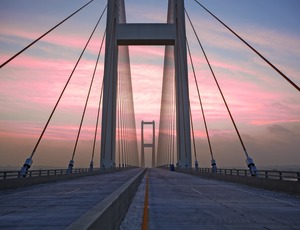

Considered to be the longest cable-stayed span in North America, the John James Audubon Bridge now connects U.S. 61 to Louisiana Highway 1 as well as the communities of New Roads and St. Francisville, La., on the Mississippi River. Featuring a 1,583-ft-long main span, the 3,186-ft-long bridge is also the only Mississippi River crossing along the 90-mile stretch from Natchez, Miss., to Baton Rouge, La.
Built by the Audubon Bridge Constructors joint venture, the $409-million bridge is Louisiana's first design-build project. It is one of 55 transportation projects under the $5.2-billion Transportation Infrastructure Model for Economic Development (TIMED) program, established in 1989 by the state Legislature.
Featuring 11-ft-wide travel lanes in each direction, an 8-ft-wide outer shoulder and a 2-ft-wide inner shoulder, the bridge's deck is supported by 136 cable stays, each anchored to one of the bridge's two 520-ft-tall towers. Each tower is anchored by 42 drilled shafts set 180 ft into the riverbed.
"Dealing with the unpredictable water elevations of the Mississippi River was by far the most challenging aspects of the project from a construction perspective," said Frank Daams, project manager at Flatiron. "Optimizing the cable and deck design to optimize the capacity of the erection equipment and the erection schedule was by far the most interesting aspect of the project."
Because a conventional sheet-pile cofferdam would have been difficult to use due to the variable water levels during construction, the contractor employed a cofferdam design for the bridge using a combination of precast concrete panels and sheet piles. With a 160-ft by 64-ft footprint, the final structure is three stories high and weighs 5,000 tons. Once assembled, hydraulic jacks were installed, and the cofferdam was incrementally lowered 47 ft into the river. The team had never before attempted the maneuver at such a large scale.
Other innovations included drilled shafts in the Mississippi River and prefabricated steel "lost" forms on the inside of the towers used for the stay-pipe system to assure perfect alignment, Daams explained.
"The drilled shafts and footings constructed in the river were different and complex to build. We used template-mounted oscillators to install temporary casings that assisted with the construction of the drilled shafts. Tip-grouting of the drilled shafts' tips was used to engage their end-bearing capacity, and multiple load tests verified the effectiveness," Daams said. "The composite deck structure, made out of steel beams and precast slabs, was designed to facilitate fast erection of the main span. Our best-ever cycle times were achieved."
As for local impacts, the bridge replaced the New Roads/St. Francisville ferry system, which transported some 720 vehicles per day and, previously, was the only traffic crossing point on the river between Baton Rouge and Natchez.
"The bridge has been a vital connector … from the day it opened," said Maria Bowen, executive director of the Zachary Taylor Parkway Association. In fact, the opening was two months ahead of schedule: On May 5, 2011, crews delivered an emergency early opening of the bridge at the request of the Louisiana Dept. of Transportation and Development to counteract excessive flooding in the area.
"The opening of the Audubon bridge has also connected the Zachary Taylor Parkway, [and we have] really been able to focus efforts on building growth and maximizing the synergy of our eight parishes," Bowen said. "We've begun to look at how we can support and expand what we already have in the region and how to energize our group to create new possibilities."
The new crossing also has spurred local economic development, although specific numbers have yet to be determined.




Post a comment to this article
Report Abusive Comment